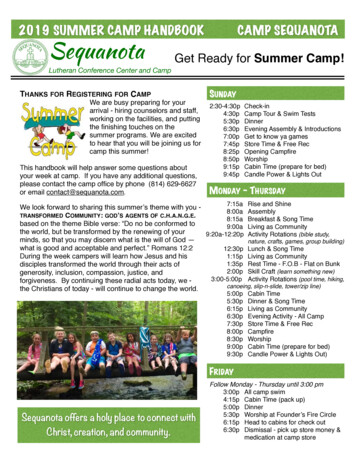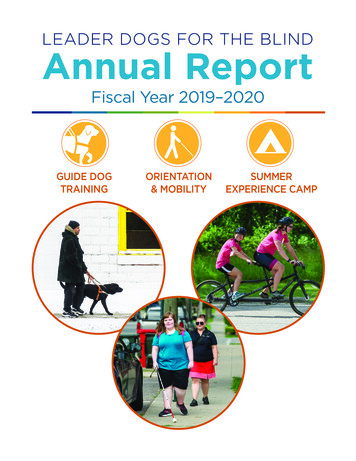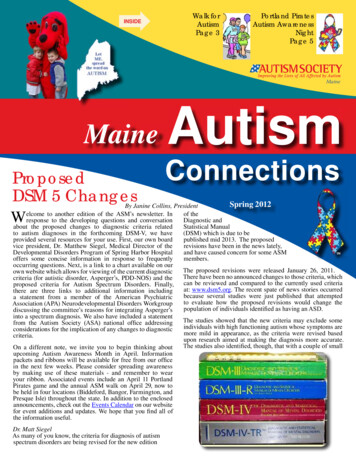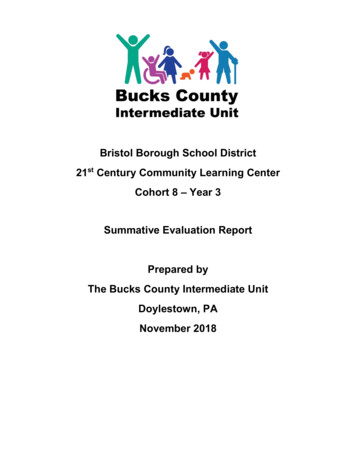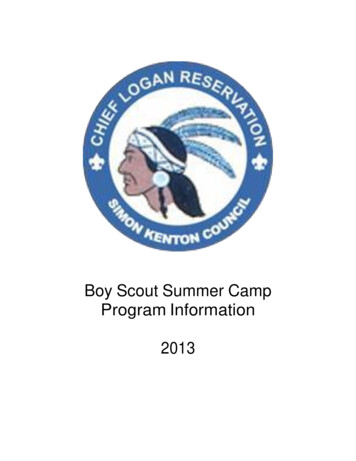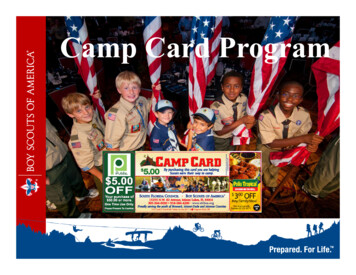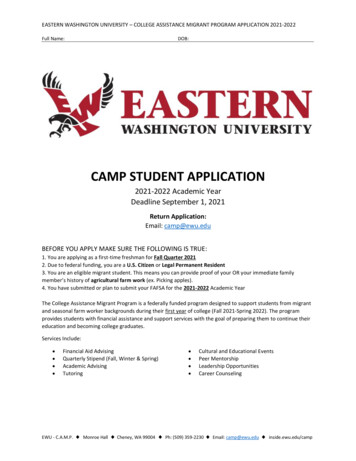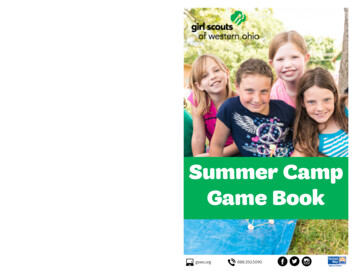
Transcription
Summer CampGame Book
Table of Contents Have each group (with an adult) go on their hunt for anywherefrom 15 minutes (younger students) to several hours (olderstudents). Gauge the interest level of the group and what youthink they (and you) can handle. Have everyone return to a common area, and share stories abouttheir adventures—what items they found, what questions theyhave about them and what they found or experienced along theway. Sometimes skits or acting out parts of the adventure cansucceed where a simply retelling will not. If there are safety hazards that came up along the way, this is agreat time to make sure everyone recognizes them and knowswhat to do if they encounter them along the way. If the items were brought back, this is great way to establish a"Nature Museum.” This can be something that each child has attheir home, or that is collectively held by a group that meetsongoing like schools, scouts or other groups. The museum inturn inspires future discoveries and new stories. Nature scavenger hunts give permission to get muddy; to goplaces that children (or adults) might not ordinarily go; as well ashaving more of a sense of wonder and curiosity without knowingfor sure what will happen next! Adventure is part of the game,and you can tailor the difficulty of the object list to match theexperience/skill level of the participants. The sense of wonder evoked, as well as the opportunities forlearning for both children and adults from a Nature ScavengerHunt makes it a top choice for getting to know more aboutwhatever natural area you are spending time in.Get To Know You GamesDizzy Delores . 8Group Juggling . 8Guess Who . 8I Would Like to Welcome You . 9Name Motion Games . 9Name Race . 9Who, Who, Who . 10Zip, Zap, Zoom . 10No Prop GamesAnimal Rummy . 12Back to Back . 12Bandit . 12Barnyard . 13Bat and Moth . 13Big Wind Blows . 13Buzz . 14Camping Trip . 14Cannibals and Missionaries . 15Catch One Catch All . 15Circle Slap . 16Colored Eggs . 16Come A Little Closer . 17Elephant, Palm Tree, Giraffe . 17Elves, Giants and Wizards . 18Frogger . 19Get the Point. 19Green Grass Door . 20Ha-Ha-Ha . 20Honey I Love You . 21Indy 500 . 21Jamaquack . 22John Jacob Jingleheimmer Schmidt . 22Knights, Horses and Cavaliers. 23Mrs. Mumble . 23Noodle Doodle . 24Number Game . 24Question Game . 24Pass the Story . 25People to People. 25Possum . 25Rhythm . 2605-208-02/201787
Nature Scavenger HuntA nature scavenger hunt is amazing at leading children into discoveryof the natural world. No matter what items are officially part of the“hunt”—mysteries abound.Discoveries lead to questions about nature that had nothing to dowith the items on the hunt—or frequently to a greater level of depththan anyone present knows the answers to. Stories by childrenabout their time in nature acting as detectives are precious and actas springboards to future hunts and further exploration.Some helpful hints to facilitate a scavenger hunt: Make sure to investigate your potential site before the hunt togauge how challenging the list of items you've created is, andhow much time will be needed based on the terrain. Also, youwant to make sure to identify any major safety hazards thatchildren may encounter so you can let them know about thesebefore they start.Create a list of items to search for, and give copies to each child.Some items commonly included on scavenger hunts include thefollowing, and we encourage you to add your own ideas: . animal tracks objects of certain colors animal burrows or dens, leaves or animal bones, animal scat (poop) feathers nuts, seeds or cones frogs and lizards, flowers from plants, insects, snakes/snakeskinBased on the number of children participating, determinewhether everyone will be together in one group, or whethersmaller sub-groups are doable. Remember, the smaller thegroup size the more chance the everyone will be able to makeindividual discoveries and have more attention from the groupleaders.Decide up front whether children will be simply checking theitems off on a list, drawing pictures of what they observed (greatfor work with nature journals and extending this activity in thefuture) or actually bringing the items backRubber Band . 26Sardines . 27Sewing Up the Gap . 27Scream . 28Sharks and Minnows . 28Ship Captain . 28–29Singing Syllables . 30Skin the Snake . 30Snaps . 31Snort . 31Spiders and Flies . 32Streets and Alleys . 33Tornado . 33What Are You Doing? . 34Why Do You Like Your Neighbor? . 34Whoops Johnny . 35Whoosh . 36Fun GamesBanana . 38Bugs in my Cup . 38Catch the Dragon’s Tail . 38Chicken Picks . 39Doggy Doggy Where’s Your Bone . 39Electric Hands . 40Foghorn Leghorn. 40Predator and Prey . 41Spud . 41Steal the Bacon . 42Tag GamesAmoeba Tag . 44CYB Tag. 44Elbow Tag . 44Elevator Tag. 45Go Tag . 45Hospital Tag . 46Octopus Tag . 46Toilet Bowl Tag . 47Night GamesFlashlight Tag . 50Statues . 5186
Raccoon HandsInternational GamesAmpe’ . 54Down Down Down. 54Duck Duck Goose . 55Oonch Neech . 55Stop There . 56Stuck in the Mud. 57What’s the Time Mr. Wolf . 57Parachute GamesBall Surfing. 60Cat and Mouse . 60Circular Sit-ups . 60Climb the Mountain . 61Color Call . 61Cops and Robbers . 61Floating Mushroom . 62Gophers . 62Housekeeping . 62Igloo . 62Jumbo Mushroom . 63Mushroom . 63Ostrich . 63Popcorn . 64Rocking Chair . 64Sharks and Lifeguards . 64Snake Tag. 65Spin Out. 65Wave Machine . 65Waves Overhead. 66This activity focuses on an animals sense of touch.PrimerUse the touch of Raccoons, and experience how animals and senseof touch are so important. Raccoons practically feel their waythrough the world. They don't have good vision or great hearing, butthey have long and amazingly sensitive fingers. They can use them tobreak into our garbage cans and then feel for the food they want! Sowhile keeping your Owl Eyes stretched and your hearing tuned, feelwith your skin.Feel the clothes on your body. Feel your feet touching the ground.Do you feel heavy? Light? Do some parts of your body feel cold andsome warm? Feel the sun on your skin. Feel the wind on your skin.which way does the wind blow? Feel your heart beating.How To:Collect a group of items from nature (i.e. tree ring, stone, leaf, orshell).Have the group close their eyes (blindfolds are optional) and givethem something to touch and feel with their hands. Can they tellwhat it is without using any of their other senses?Have the girls work in pairs and have one partner hand items to herblindfolded partner and have them try to stump each other.Noodle GamesAtom Splitters . 68Circle Drop . 69Clothespin Samurai. 69Delta Tag . 69Flippin Burgers. 70Mars Attacks . 70Noodle Fencing. 71Noodle Jousting. 71Old One Tooth. 72Parco Molo . 73Swattin Flies . 7485
Dirt For DessertThis activity uses layers of dessert to demonstrate soil horizons. Thisactivity takes about 20 minutes to make and requires 2–3 hours ofrefrigeration. Best of all you can eat the results!Supplies: Large package chocolate sandwich cookies 2/3 Cup powdered sugar 2 8oz packages cream cheese 2 large packages of instant chocolate pudding Milk as per pudding directions Gummy worms 12 oz. whipped topping Large storage bags (One to two) Rolling pin 2 large mixing bowls Measuring cups Large clear plastic/glass bowl Optional: coconut dyed with green food coloring.Preparation Directions1. Crush up the sandwich cookies and add the worms to it to makethe soil mixtures.2. In one bowl, mix together powdered sugar and cream cheese.3. In another bowl, use an electric mixer and mix pudding with milk.Add pudding mixture to cream cheese mixture. Fold in Whippedtopping.4. Now it is time to make the layers. Start with a layer of soilmixture on the bottom of the clear plastic/glass bowl. Then addalternating layers of pudding mixture and soil mixture. Make surelast layer (on top) is the soil layer.5. If desired, sprinkle green coconut on top of dessert to simulategrass.6. Refrigerate for dirt dessert for 2–3 hours.7. When serving, have the girls note how the bottom layer was putthere first and the top layer last. This is how soil formationworks.84Earthball GameCrab Soccer . 76Earthball Bowling . 76Earthball Dodgeball . 77Earthball Pass . 77Earthball Relays . 77Gauntlet . 78Keep the Earth Afloat . 78Taps TalksHigh/Lows/Uh-O’s or Roses and Thorns . 80Impression Feet/Hands. 80Sweet-Tarts . 80Nature ActivitiesFind a Tree . 82Eagle Eye . 83Dirt for Dessert . 84Raccoon Hands . 85Nature Scavenger Hunt . 86
Why Games Are Used In Girl Scouting Introduce girls and counselors in a fun and easy way. To meet the needs of the group and individuals. This may includethings such as teamwork, fair play, winning and losing while stillenjoying the game, goal setting as well as how to be leaders andfollowers. To teach, review, or practice skills or information in a fun way.How To Teach Games1. Choose games to teach according to:A. The ages, interests and abilities of the girlsB. The special purpose you want each game to serve.C. The size and kind of play space available.2. Get the girls’ attention and have them get into formation for playingthe game.3. Explain or show the game briefly and let them play right away.4. If the game is at all complicated, show them one part at a time,letting them try each part immediately.5. Let them have fun with the game before you check on mistakes,but stop them when necessary to make the rules or actions clear.6. Your participation is important! It helps the girls maintaininterest and control. Get involved, play with the girls.7. Stop the game after a reasonable time even if some girls beg tocontinue. If they play it to death the first day, they lose the fun ofcoming back to it.8. In competitive games, encourage the girls to play for the fun of thegame and for their team. Teach good sportsmanship and toapplaud or otherwise recognize the winning team.9. The above directions apply to singing games, with these additionalsuggestions:A. Sing the song first, without the action and with the girlslistening for one part of the singing game at a time.B. Then sing the part, a line at a time and have the girls sing backto you like an echo.C. Then sing and show the accompanying action, one part at atime.D. Have the girls sing and try acting, asking them to sing softlyuntil they are sure of the melody.E. Once they are enjoying the swing of the game, correctmistakes. Be sure to keep the singing musical.Eagle EyePrimerEagles have incredibly keen vision. From hundreds of yards above afield, or sitting high in a nest overlooking a river, they can spot asmall rodent or splashing fish. When they do, they lift and swoopright down to grab that little morsel of delicious food! Humans havegood vision too, but we can learn a lot by watching eagles and hawks.Eagles and hawks don't even have to move to spot somethingbecause they use their keen vision. If you practice using Owl Eyes—or Eagle Eyes—you'll be able to see more animals hiding from you. Doyou think if we all went out and hid, that you could stand still andspot us without moving or walking around?How To:Directions for the Eagle. This outdoor game is a sedentary variationon hide–and–seek. Play it in an area with some decent cover forhiding: bushes, ferns, tall grass. One person will be chosen as theEagle, who must stand in his "Eagle Nest" that consists of about therange of his/her pivot–step. I usually start by having an instructorstay with the Eagle during the game as a facilitator. The Eagle closeshis/her eyes and counts to 60 while everyone else hides in a broadcircle around the Eagle Nest (define the boundaries).Directions for hiders. All hiders or "voles/mice/rabbits" must hidethemselves in such a way that they can see the Eagle with at leastone eye at all times. This means no hiding completely behind trees.They must also hide within the boundaries. The game goal—peoplewant to get as close to the Eagle as possible and not be seen. This isthe true test of invisibility.Eyes Open. The Eagle opens his eyes and looks (and listens) allaround for everyone hiding, but she cannot leave the nest. When theEagle sees something that might be a person hiding, he mustdescribe the colors of the clothes or hair he sees and point to theexact location, it will be clear that the person has been seen. Thatperson comes to the Eagle Nest and sits down, remaining silent notgiving anyone else away. Again, the Eagle listens in the silence for anymovement of other people hiding.Sustain Pace. After a while, when the Eagle cannot see any morepeople, have her close her eyes and count to 30 while everyonequickly hides again, moving at least five steps closer to the Eagle thistime. Keep playing like this until Eagle finds everyone or until oneperson remains. Ask the last person hiding to give a bird call soeveryone can locate their number one hiding spot. In this way, thegame stays interesting and fun for everyone involved, without laggingor becoming boring.83
Find A TreeThis is a fun nature activity which will help to develop your sense oftouch and smell. Both of these senses, along with all the others arevery useful in the natural world. You will need to be around afew trees. A back yard or a park will work well.As few as two players, or up to about 10 can play this game. Eachplayer chooses a partner. One partner is blindfolded with a bandanaor any other handy blindfold. It's ok to just close your eyes, but nopeeking is allowed or the game will not work.The seeing partner carefully leads the blindfolded partner to a tree.Remember, seeing partner, you are responsible for keeping yourpartner safe. The blindfolded person then feels the tree with herhands. How does it feel? Rough? Smooth? Big? Small? Ridges?Holes? Try to learn as much as you can about that tree with yoursense of touch. Then smell the tree. Go ahead, put your nose rightup to the bark. It won't hurt you. How does it smell? Sweet? Sour?Old? New? Like the earth? Like wood?Now lead the blindfolded person back to the starting spot. Take offthe blindfold. The goal in this nature activity is to find the tree. Useyour sense of direction, sense of touch, and sense of smell. Oncefound, reverse roles and let the other partner be blindfolded. You willbe surprised how much you will learn in this simple nature activity.Here is a hint to make it more interesting. Don't lead the blindfoldedperson directly to the tree. Walk him or her in circles for a while tomake it more challenging.Ok, now its time to play the game.Warning: Trees with vines on it may have poison ivy and shouldbe avoided.82Get to Know You Games
Dizzy DeloresThe first person gives his name plus an adjective that begins with thefirst letter of his nameExample: Hungry Harry or Silly SallyThe next person repeats the first’s name and then gives his own. Thegame continues around the circle with each person repeating thenames of everyone before, then saying their own.Group JugglingNeed: Several small balls (koosh balls etc.)This is a great get to know you game as well as team builder.Group leader starts out with the ball and chooses someone in thecircle, says their name out loud and then throws them the ball.Instruct all players to throw the ball to someone who has not had theball thrown to them before. It should end with the ball being thrownback to the leader after everyone else has had the ball.Do it a second time and have them throw to the same person as inround one and as the ball gets through four to five people throw in asecond, third, forth ball or however many the group can handle.**To turn this into a team builder, try to have them do it faster andfaster and to try to decide what is the best way to do it is. Keep themgoing until they come to the conclusion of standing in order of whoyou threw it to.Guess WhoNeed: Bed sheet, blanket or something to divide groupsDivide the group into two teams and place each team on differentsides of the sheet. Two people (adults) hold the sheet up betweenthe two groups.Each group selects one person to sneak up on their side of the sheetand wait. Once both teams have selected someone and they areready the sheet is dropped and the person who yells out the name ofthe other person first wins the round. The winner gets to take theother player for their team.A team wins once they get all the players on their team.8Nature Activities
Highs/Lows/Uh-Os or Roses and ThornsGood way for everyone in the group to go around the circle and voicetheir goods and bads about the day.I Would Like to Welcome YouEveryone stands in a circle. (Give everyone a scrap piece of paper tostand on.) One person begins the game in the middle of the circle.The person in the middle says, “I would like to welcome everyonewho .” And they fill in the blank.Example: .has on green or has ever been to the ocean.Impression Feet/HandsWhat/Who made an impression on you today? Who is someone inthe group that you would like to give a hand (compliment) to?Everyone who fits into that category then moves to a new spot. (Mustmove at least 2 spots away from their original spot.) The personwithout a place is now in the middle.Name Motion GameEveryone in the circle thinks of a motion for each syllable in their firstname (i.e. click fingers, slap knees, touch ear or jump up).Sweet-TartsEach person shares one thing they are looking forward to or excitedabout and one thing they are anxious about.The leader starts by stating their name and doing the motions.Everyone in the circle repeats the name and motion. Go to the nextperson. Have everyone repeat this name and motion, then go backand do the first person again. Keep adding new names, practice th
the game. 3. Explain or show the game briefly and let them play right away. 4. If the game is at all complicated, show them one part at a time, letting them try each part immediately. 5. Let them have fun with the game before you check on mistakes, but stop them when necessary to make the rules or actions clear. 6. Your participation is important!
